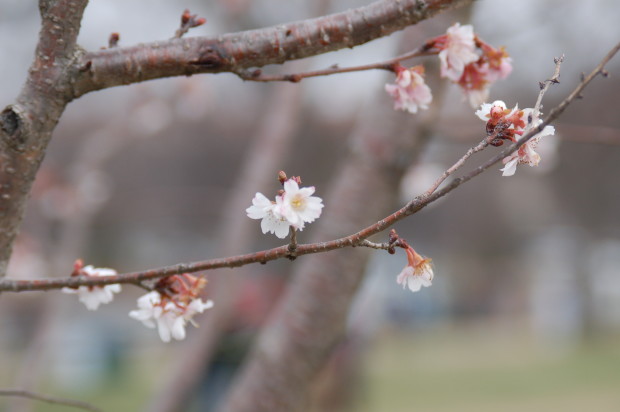We have much more to do and your continued support is needed now more than ever.
Inauguration Cherry Blossoms: A Harbinger of Climate Impacts to Come
Making my way across the grounds of the Washington Monument yesterday to witness Barack Obama’s second inauguration, I came across a disconcerting sight. Lulled by unseasonably warm temperatures and a false sense of spring, the pale pink petals of young cherry trees had emerged in the dead of winter. The blossoming of Washington’s famed cherry trees normally is much-anticipated and a cause for celebration. The blooms I saw as the inaugural pageant was playing out didn’t serve as a harbinger of spring, though, but rather a sign of how climate change is altering the rhythms of our natural world.

Climate scientists at NOAA recently announced that in the continental United States, 2012 was the hottest year since record-keeping began 118 years ago, blowing past the previous record by a full degree. The effect of these increasingly warm temperatures is already showing in our woods and meadows. Just last week scientists reported record early flowering times for dozens of spring wildflowers in the eastern United States. Using notes from famed naturalists Henry David Thoreau and Aldo Leopold, research teams documented that flowering is now occurring up to three weeks earlier than in Thoreau and Leopold’s time, 160 and 80 years ago respectively.
While an early spring may not sound too bad to winter-weary New Englanders, many plants and animals depend on the linked timing of other species to survive—for instance, the timely emergence of insects for birds to feed to their chicks, or the arrival of bees or hummingbirds to pollinate flowers. Accelerate or delay one side of the interaction and the other can suffer in response. This form of ecological mismatch is just one example of the impacts of climate change on species and ecosystems that were summarized in a recent report to the National Climate Assessment, on which I was a co-author.
As I stood on the grounds of the Washington Monument with thousands of others yesterday, I was thrilled to hear President Obama speak very directly about the need to finally confront the dangers climate change poses to America. “We will respond to the threat of climate change, knowing that failure to do so would betray our children and future generations.” He then noted that “some may still deny the overwhelming judgment of science, but none can avoid the devastating impact of raging fires, and crippling drought, and more powerful storms.” Indeed, the science is now clear; it is only the political science and our will to act that is in doubt.
Early this morning as I stepped outside to walk my dog, temperatures in Washington hovered around 19 degrees, a dramatic dip from the previous day’s relatively mild temperatures. Such cold days are now becoming a rarity in Washington, and I found myself savoring the bite of the winter air. I couldn’t help but think, though, about the now-frozen petals on the National Mall, and the young trees that, come spring time, would be without cherry blossoms. Washington’s cherry blossoms long have been a national treasure. It’s time we listened, as the president clearly did, to what they are telling us.
Speak up for wildlife, like polar bears, and support limits on carbon pollution from power plants!






















